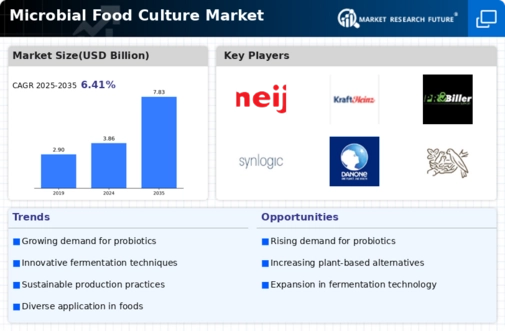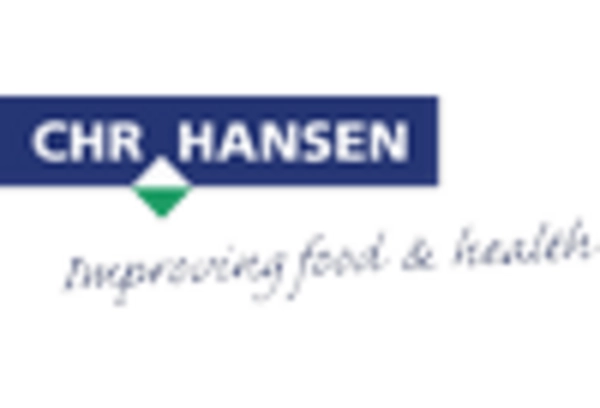Growing Awareness of Probiotics
The rising awareness of probiotics and their health benefits is significantly influencing the Microbial Food Culture Market. Probiotics are live microorganisms that, when consumed in adequate amounts, confer health benefits to the host. The market for probiotic products is expected to reach USD 70 billion by 2026, driven by consumer interest in gut health and immunity. This awareness is prompting food manufacturers to incorporate specific microbial cultures into their products, thereby enhancing their appeal and marketability. As consumers become more health-conscious, the demand for probiotic-rich foods is likely to continue its upward trajectory.
Shift Towards Plant-Based Diets
The shift towards plant-based diets is emerging as a significant driver in the Microbial Food Culture Market. As more consumers adopt vegetarian and vegan lifestyles, there is a growing demand for plant-based fermented products. This trend is prompting food manufacturers to explore new microbial cultures that can effectively ferment plant-based ingredients, thereby creating innovative products that cater to this demographic. The plant-based food market is projected to grow at a CAGR of 11% over the next five years, indicating a substantial opportunity for microbial food cultures that align with this dietary shift.
Rising Demand for Fermented Foods
The increasing consumer preference for fermented foods is a notable driver in the Microbial Food Culture Market. Fermented products, such as yogurt, kefir, and kimchi, are gaining popularity due to their perceived health benefits, including improved digestion and enhanced gut health. According to recent data, the fermented food segment is projected to grow at a compound annual growth rate of approximately 8% over the next five years. This trend is likely to encourage manufacturers to invest in microbial food cultures that enhance the flavor and nutritional profile of their products, thereby expanding the market further.
Regulatory Support for Fermented Products
Regulatory support for fermented products is playing a pivotal role in the Microbial Food Culture Market. Governments and health organizations are increasingly recognizing the health benefits of fermented foods, leading to favorable regulations that promote their consumption. This support is likely to encourage food manufacturers to invest in microbial cultures that comply with safety and quality standards. Additionally, initiatives aimed at educating consumers about the benefits of fermented foods are expected to further boost market growth. As regulatory frameworks evolve, they may provide a conducive environment for innovation and expansion within the microbial food culture sector.
Technological Advancements in Food Processing
Technological advancements in food processing are reshaping the Microbial Food Culture Market. Innovations such as high-throughput screening and genetic engineering are enabling the development of novel microbial strains that can enhance food quality and safety. These advancements allow for the production of tailored microbial cultures that meet specific consumer needs, such as lactose-free or gluten-free options. The integration of technology in food production is expected to drive efficiency and reduce costs, making it a crucial factor in the growth of the microbial food culture sector. As a result, manufacturers are increasingly adopting these technologies to stay competitive.


















Leave a Comment